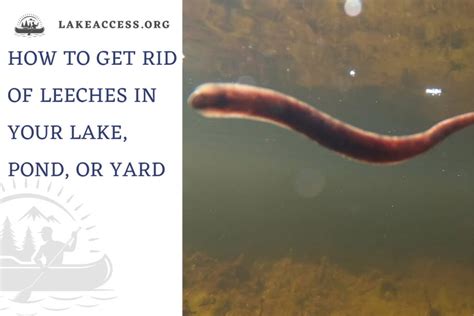How Do You Get Rid Of Leeches In A Lake
Ronan Farrow
Apr 04, 2025 · 3 min read

Table of Contents
How to Get Rid of Leeches in a Lake: A Comprehensive Guide
Leeches in a lake can be a nuisance, impacting both the aesthetic appeal and the recreational use of the water body. While completely eradicating leeches might be impossible, you can significantly reduce their population and mitigate their impact. This guide explores effective strategies for leech control in lakes, focusing on environmentally friendly and sustainable methods.
Understanding the Leech Problem
Before diving into solutions, it's crucial to understand why leeches are present and what factors contribute to their proliferation. Several conditions can lead to a large leech population:
- Abundant Food Source: Leeches thrive where there's an ample supply of their preferred food sources, typically other aquatic organisms like fish, amphibians, and invertebrates. A healthy ecosystem with a diverse food web can inadvertently support a large leech population.
- Suitable Habitat: Shallow, weedy areas with plenty of decaying organic matter provide ideal breeding and hiding grounds for leeches. Areas with slow-moving or stagnant water are particularly attractive.
- Lack of Natural Predators: A decline in the population of natural leech predators, such as certain fish and birds, can lead to an imbalance in the ecosystem and an increase in leech numbers.
Effective Leech Control Strategies
Completely eliminating leeches from a lake is impractical and often environmentally damaging. The focus should be on controlling the leech population to a manageable level. Here are some proven strategies:
1. Improve Water Quality and Habitat Management
- Reduce Nutrient Runoff: Excess nutrients from fertilizers and sewage stimulate algae growth, indirectly supporting the food web that sustains leeches. Implement measures to reduce nutrient runoff from surrounding areas.
- Manage Aquatic Vegetation: Controlling excessive aquatic plant growth reduces the available habitat for leeches. Careful and selective removal of weeds can be effective. Avoid harsh chemicals that can harm the overall ecosystem.
- Enhance Water Flow: Improving water flow can disrupt leech breeding grounds and make the environment less hospitable. This might involve dredging or manipulating the lake's drainage system.
2. Biological Control Methods
Introducing natural predators can help manage leech populations. This approach is generally preferred over chemical methods due to its environmental friendliness. However, introducing new species requires careful consideration of potential ecological impacts and should be undertaken with expert guidance.
3. Physical Removal
- Manual Removal: In smaller, localized areas, you can manually remove leeches. This is labor-intensive but can be effective for small-scale infestations.
- Specialized Traps: There are commercially available leech traps that can be used to capture leeches. These are most effective when deployed in areas with high leech concentration.
4. Chemical Control (Use with Extreme Caution)
Chemical control methods should be considered a last resort due to their potential negative impact on the entire lake ecosystem. If you opt for this approach, consult with a qualified aquatic ecologist or environmental professional to select appropriate chemicals and ensure their safe and responsible application.
Preventing Future Leech Infestations
Prevention is key to minimizing leech problems. Implement the following measures:
- Regular Monitoring: Periodically inspect the lake for leech activity to detect infestations early.
- Proactive Habitat Management: Continuously maintain good water quality and manage aquatic vegetation to prevent favorable leech breeding conditions.
- Educate Lake Users: Inform lake users about leeches and responsible practices to avoid contributing to the problem.
Disclaimer: This guide provides general information. Always consult with relevant experts for site-specific advice and to ensure the chosen methods are appropriate for your particular lake environment. Improper handling of chemicals or introduction of non-native species can have serious consequences for the aquatic ecosystem. Remember that maintaining a healthy balance in your lake's ecosystem is crucial for long-term leech control.
Featured Posts
Also read the following articles
| Article Title | Date |
|---|---|
| How Effective Was Samurai Armor | Apr 04, 2025 |
| How Does The Perfect Marriage End | Apr 04, 2025 |
| How Do Baptists Celebrate Easter | Apr 04, 2025 |
| How Do I Crop An Image In Cricut Design Space | Apr 04, 2025 |
| How Did Fern Coppedge Die | Apr 04, 2025 |
Latest Posts
-
How Long Does A Breach Of Contract Lawsuit Take
Apr 05, 2025
-
How Long Does A Braces Appointment Take
Apr 05, 2025
-
How Long Does A Bottle Of Testosterone Last
Apr 05, 2025
-
How Long Does A Bike Tune Up Take
Apr 05, 2025
-
How Long Does A 4 Oz Fuel Canister Last
Apr 05, 2025
Thank you for visiting our website which covers about How Do You Get Rid Of Leeches In A Lake . We hope the information provided has been useful to you. Feel free to contact us if you have any questions or need further assistance. See you next time and don't miss to bookmark.
